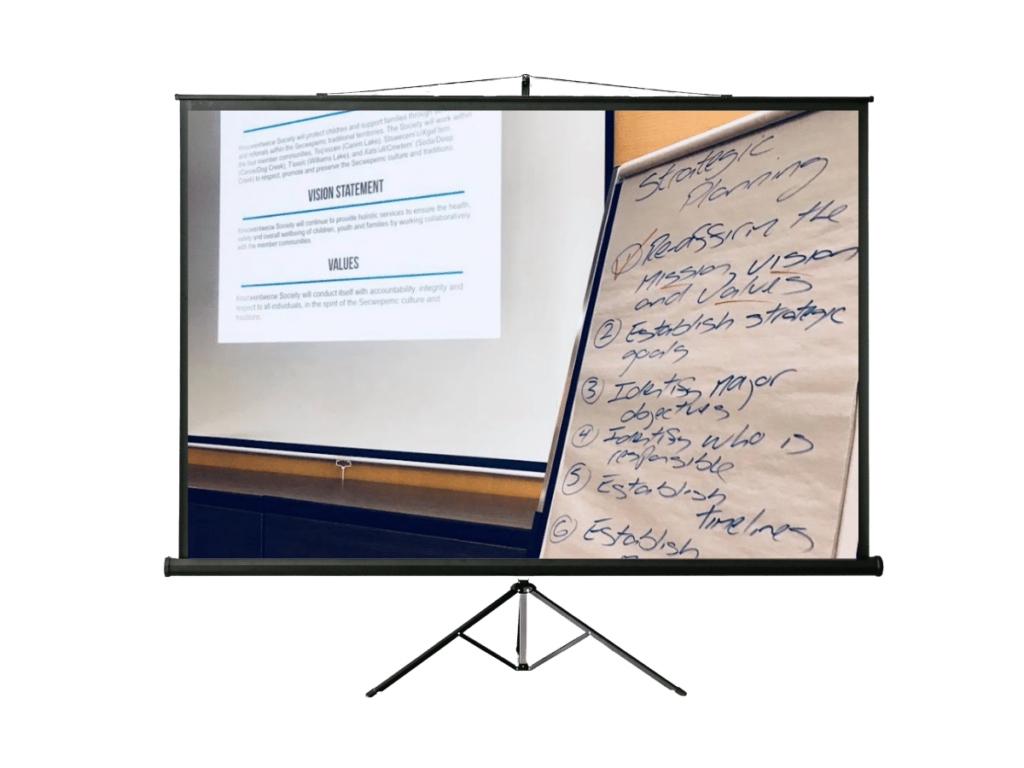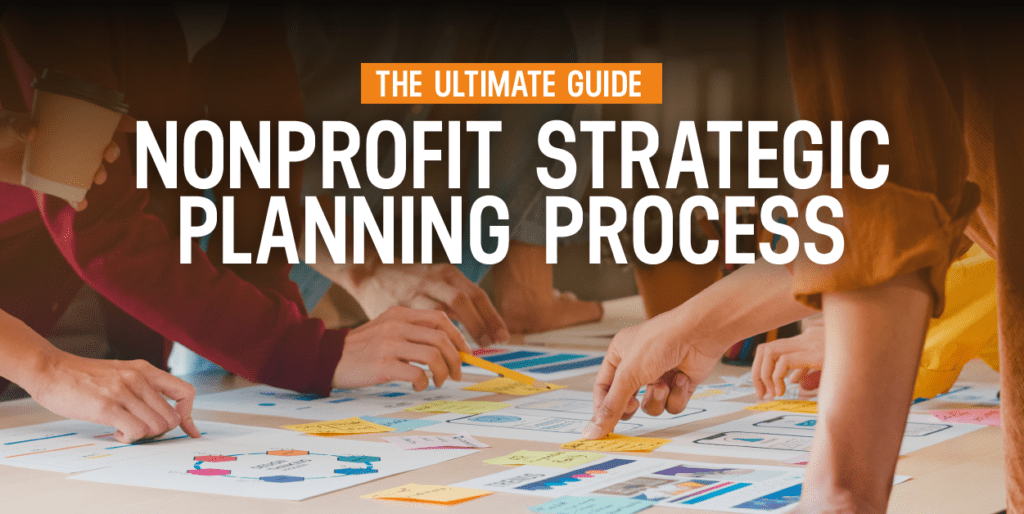
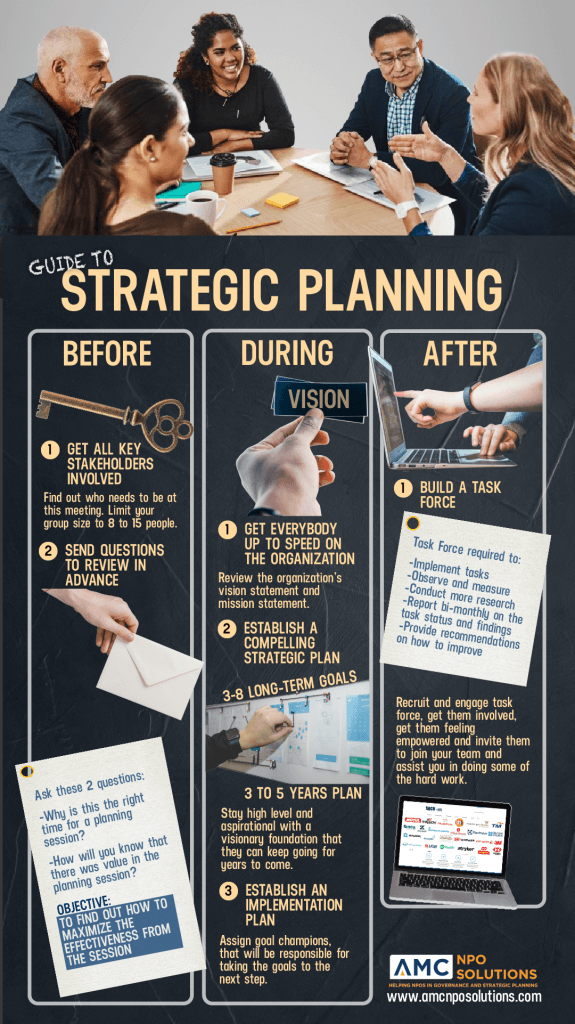
What is strategic planning for nonprofit organizations?
Nonprofit strategic planning sessions are not just a formality; they’re instrumental to your success. Nonprofit strategic planning is a critical process of identifying components that will help your organization reach its goal. Furthermore, nonprofit strategic planning also requires your organization to create goals and objectives and plan how you’ll achieve them.
Also read: Choosing A Nonprofit Strategic Planning Facilitator: A Step-By-Step Guide
How is strategic planning for nonprofits different from for-profits?
One of the most significant differences between for-profit and not-for-profit organizations is in how they gauge organizational achievement. In for-profit organizations, success is defined by how much “profit” is generated by the organization. For publicly-traded companies, success is the share price of the organization’s stock.
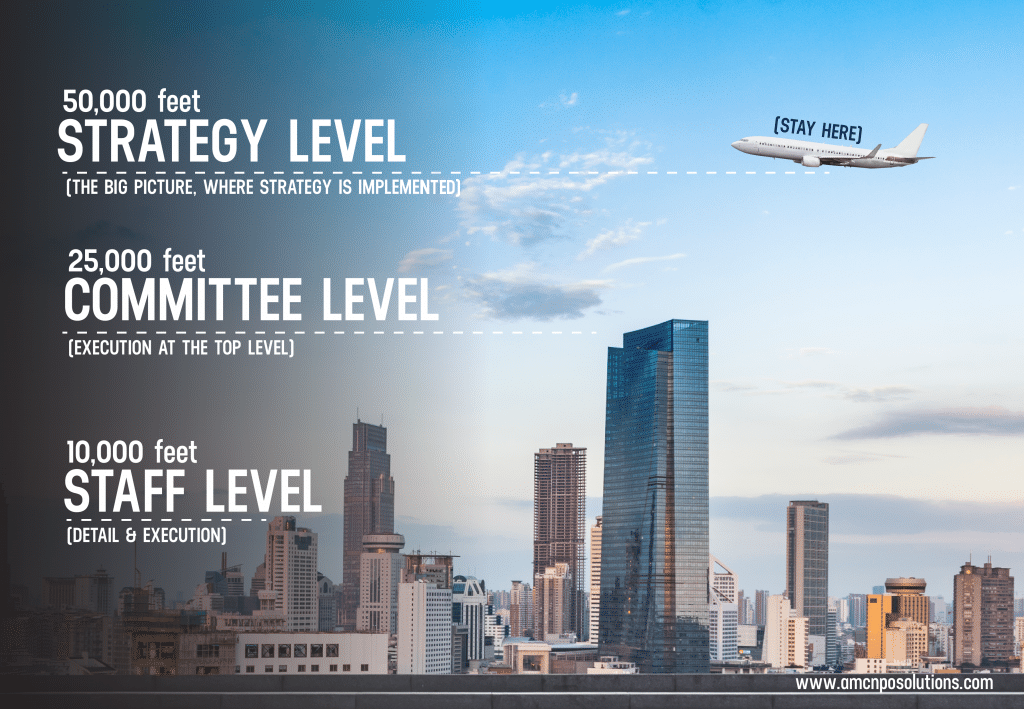
Now there are serious flaws with both of these methods of measuring performance. Foremost, there’s far too great an emphasis on short-term gains at the expense of long-term sustainability. Nonetheless, both of these measurement methods continue to be used universally in the for-profit world.
In not-for-profit organizations (NPOs), where there is no share price and “profit” (also known as “surplus”) is not the principal raison d’être of the organization, the measurement methods from the corporate environment are both inappropriate and unusable.
For this reason, the importance of strategic planning is such a vital part of managing and monitoring the NPO’s performance.
What are the benefits of strategic planning for nonprofits?
The most common challenge for nonprofits is a simple one. Amongst the hustle and bustle of wearing many hats, and somewhere along the way, as the organization’s day-to-day operations take priority, the plan—or purpose—falls to the wayside. Some organization’s boards might even begin the strategic planning process with great enthusiasm and intent yet neglect to monitor it and ultimately fail to bring their plans to fruition.
Both are huge problems considering every great expedition requires a direction, objective, and a clear definition of purpose that guides the leaders’ decisions – your nonprofit’s goals and objectives are much the same. That’s why committing to a clearly defined, accessible and accountable strategic plan comes with an array of benefits such as:
- Provides a guidepost for your board to use to navigate the vast array of challenges and choices every organization faces.
- Encourages strategic thinking all year long
- Increases board training and development
- Improves decision-making
- Enhances the legitimacy of your organization
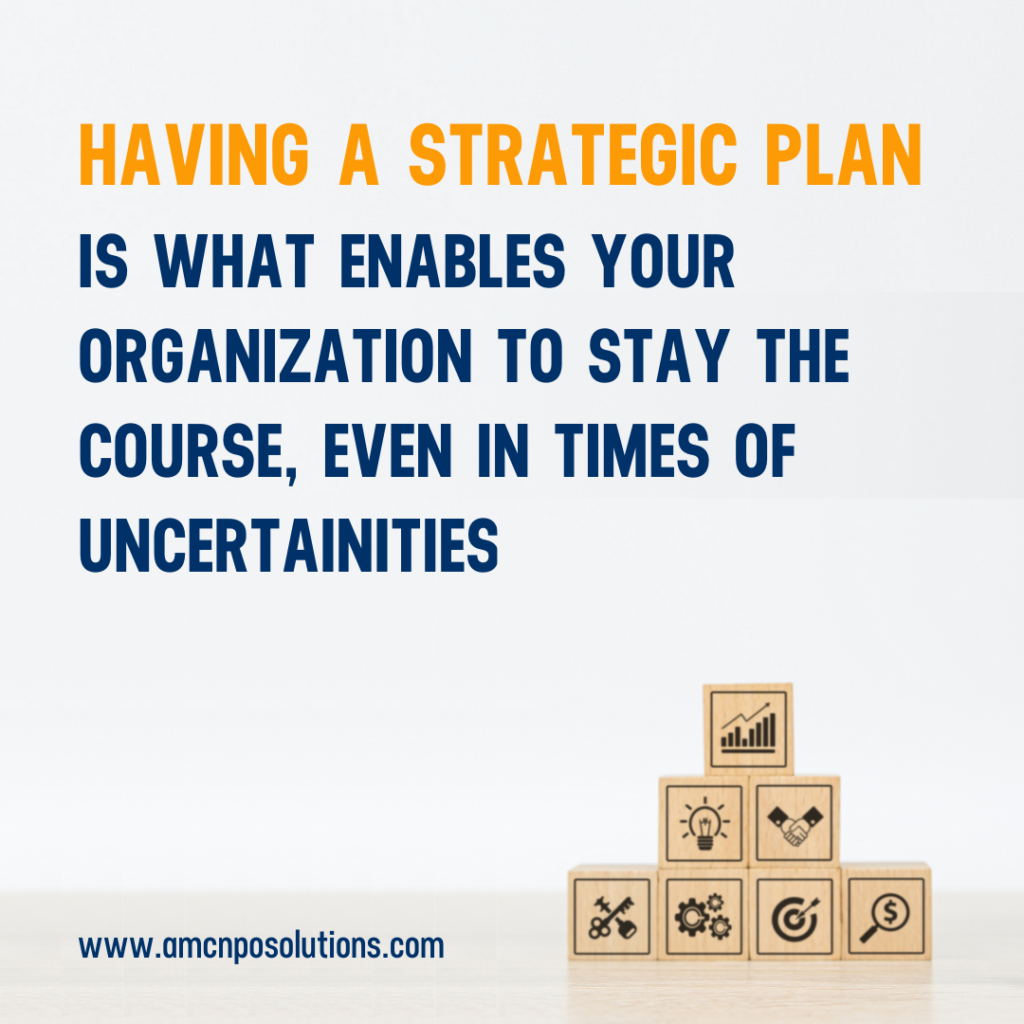
Where and when should you conduct a strategic planning session?
When a pandemic isn’t an issue, we recommend that nonprofit strategic planning sessions be a planning retreat, scheduled away from the association’s office, at a hotel or resort.
In a space removed from day-to-day office concerns, the participants can concentrate totally on the issue at hand – charting the future of their association.
Normally we suggest the session begin on a Friday, re-convene on Saturday morning and finish Saturday afternoon. These “retreats” are not for the faint of heart. They are generally intensive and exhausting sessions. Our role, as the facilitator, is to be an independent catalyst and keep the discussion focused, relevant, participatory, positive and animated.
Also read: 18 Popular Nonprofit Strategic Planning Models & Tools
Virtual Strategic Planning Sessions
Given the current circumstances the world is experiencing, many nonprofits are choosing to have their strategic planning sessions done virtually. This eliminates travel time and costs while still achieving the organization’s goals for an effective strategic planning session.
We’ve facilitated many strategic planning sessions virtually and overwhelmingly the participants have said our sessions are just as collaborative and effective as live planning sessions. But it does take an experienced facilitator to do them well.
Here’s how we do virtual strategic planning sessions:
- Keep it short to 3-hour increments to avoid ‘Zoom fatigue’
- Gather key people from all over the province and the world
- Revisit vision and mission statements
- Clarify if their goals and strategies from their last planning session are still relevant
- Use virtual breakout rooms to allow smaller teams to work on different strategic goals
- Make sure everyone leaves feeling clear on what they need to do as a society moving forward.
Download the guide on 8 reasons why strategic planning fails and learn what to do instead.
How to conduct a strategic planning session for a nonprofit organization
Here are the steps we recommend for an effective strategic planning session. Now, there are three stages when considering how to develop a strategic plan for a nonprofit organization; before, during and after the Strategic Planning Session.
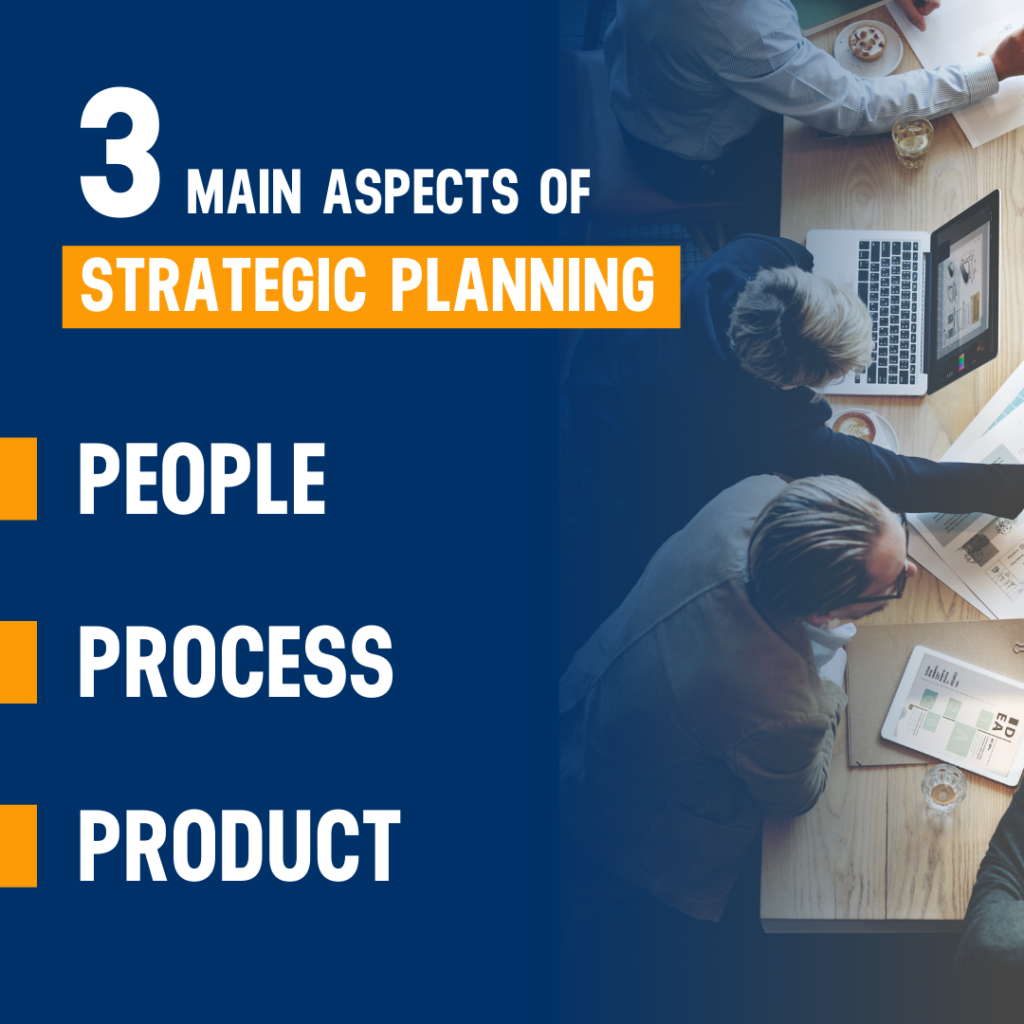
Before the strategic planning session
Invite everyone to participate
When scheduling a strategic planning session, you’ve got to get all of the key stakeholders involved. So you’ll need to find out who needs to be at this meeting.
Above all, make sure you get the entire board there. Not to mention, if you have volunteers on some committees that you think would be useful to be there, be sure to include them.
Be sure to include some key staff members, especially your executive director. Likewise, if you have some senior managers whose input would be useful, be sure to include them in the strategic planning session.
However, a word of caution- you don’t want to have too many people in the room. Generally, the more people you have, the more ideas you’ll have, which can be both good and bad.
Therefore, with more people, there will be more discussion. For this reason, typically, you add about 30 minutes to an hour of discussion for every person you add to a meeting. So keep that in mind when you’re planning who will be at your next session.
Ultimately try to limit your group size to anywhere between 8 to 15 people, which is a nice and manageable size.
Send questions to review in advance
Next, send questions to review in advance. Asking questions beforehand will help you determine how to maximize the impending strategic planning session’s effectiveness, which can be used to structure your strategic planning session.
You can ask these 3 questions:
1. Why is this the right time for a planning session?
What’s going on right now that makes having this session important or critical? Is it a new board? Do you have a new president? Have you just hired a new executive director? Is there a change in government either at the federal or the provincial level? What’s happening right now that makes this strategic planning session important?
2. What do you want to accomplish at the strategic planning session?
It’s important to find out what everyone wants to get out of the session and to manage expectations. For example, you might have some people coming to the session, wanting clarity on direction. You may have others that come to the planning session with a specific agenda. Maybe they want to embark on a new initiative or they want to talk about new programs or policies.
3. How will you know this session was successful?
So, how will you know that the session wasn’t a complete waste of your time? How will you know that there was value in the planning session? Overall, you might find some overlap and answers between question number two and question number three or you might find something completely different.
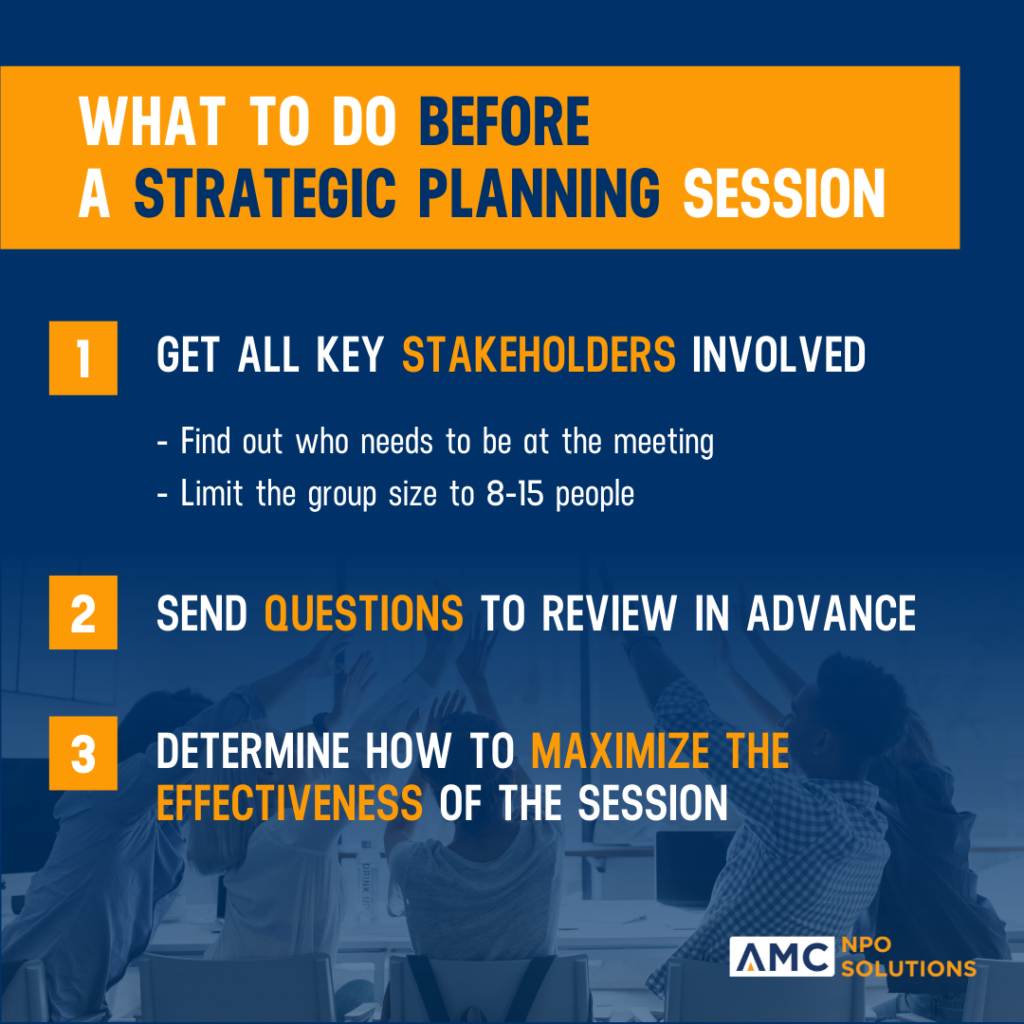
During the Strategic Planning Session
Now, during your nonprofit strategic planning session, ensure you get everybody up to speed on the organization. You can do this by reviewing the organization’s vision statement and mission statement.
Re-affirm your Vision Statement
A lot of people get vision and mission confused. A vision, by definition, is your view or image of the future. Therefore, it’s not what’s happening right now. It’s not your goals that you need to achieve today or even tomorrow—instead, it’s your dreams, your image of the future, almost like a perfect world.
In the not-for-profit sector, what we’re talking about is when your job is done, when you’ve achieved all of your goals, what will the world be like? What will your members say? Your constituents? What will your stakeholders say and do and live? What will it be like? That’s a vision statement.
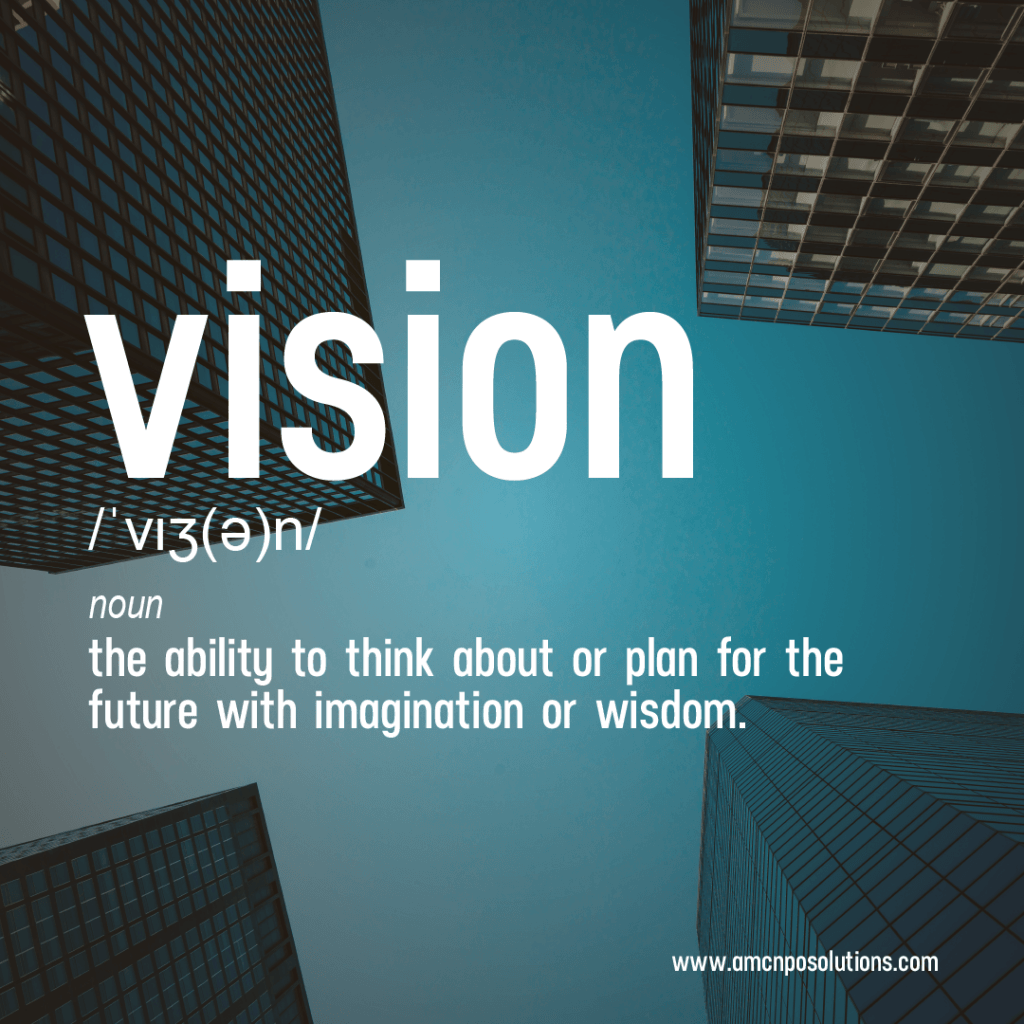
Re-affirm Mission Statement
The mission statement is a bit different. If the vision is the vision or the image of the future. The mission is what you need to be doing day-to-day. What do you need to be working on? Drives you? What are some of these objectives on a day-to-day basis?
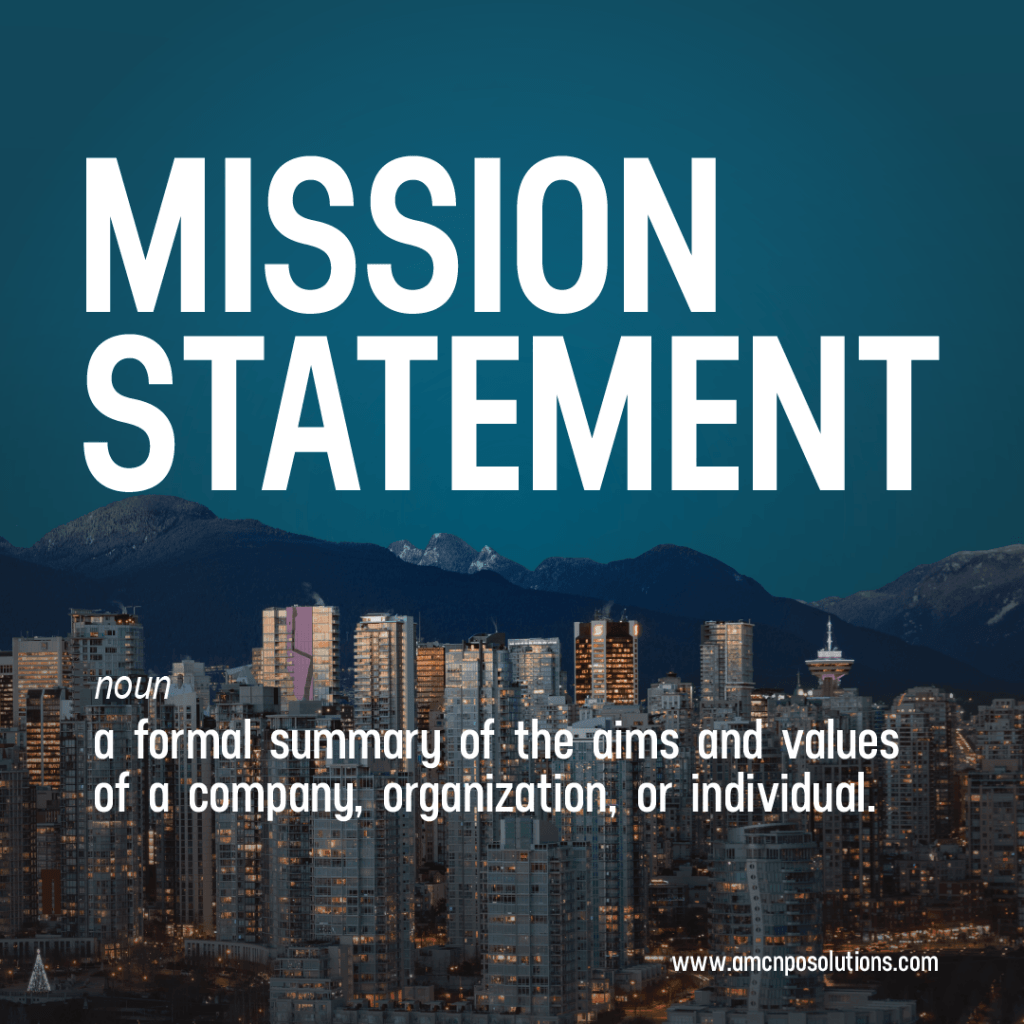
They’re still somewhat aspirational but they’re a bit closer to home than your vision.
Also read: Why Mission Statements For Nonprofits Matter Most
Consider Long Term Plans
Many boards face a challenge because when they come up with a strategic plan, it’s a one-year plan. Thus, if the task force can achieve it in just one year or one term, there’s really no continuity. There’s no long-term scope, and there’s really nothing for the board to run with and help you reach those long-term goals.
What I encourage you to do is instead is come up with a three to five-year plan. Specifically something aspirational, visionary, compelling, and one that will involve future leaders and the current ones. In short, your long-term plan is the foundation to be followed for years to come.
Create and define 3-7 Goals
During your strategic planning session, you’ll want to define between three and seven goals. Anything less than that, and you haven’t pushed yourself. Anything more than 7, I’m not sure it’s manageable.
Furthermore, you might not have the resources (time, money, effort, staff) actually to see these things through. For this reason, you might end up feeling overwhelmed, dejected and quit.
For one thing, nobody wants that. Therefore, if you focus on three to seven strategic goals that you can bring forward and work on for the next three to five years- you’ve already accomplished something.
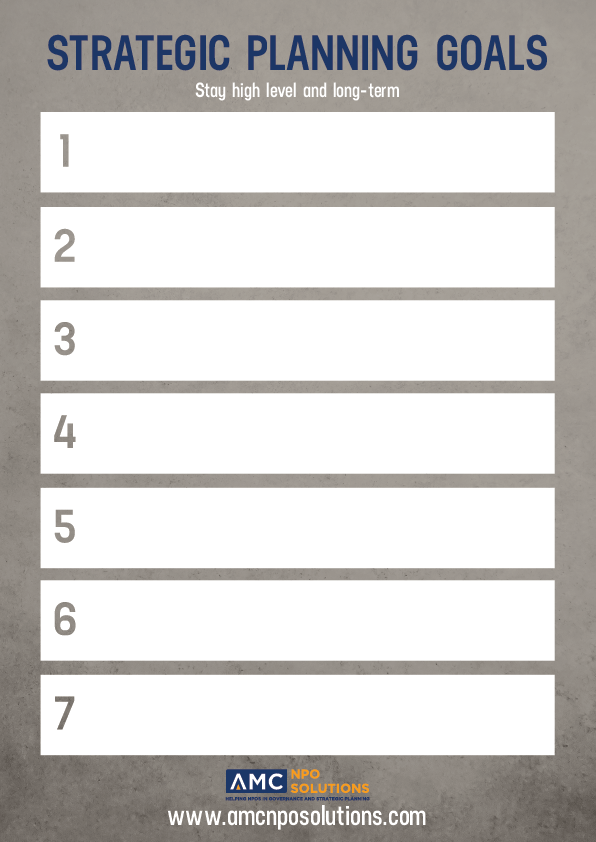
Develop an Implementation Plan
Surprisingly, this is where a lot of groups struggle and fail– they don’t have an implementation plan. At this stage, you need to know how you’re actually going to get this done. Now, some call it deployment or execution, but I call it implementation.
You’ve set the policy now, you’ve got to implement the policy. The first thing you need to do is make a decision.
Who is going to do what? By when?
Here’s something that I find useful is once you’ve nailed down those goals, you need to assign a goal champion or a goal ambassador. Someone responsible for taking that goal forward to the next step.
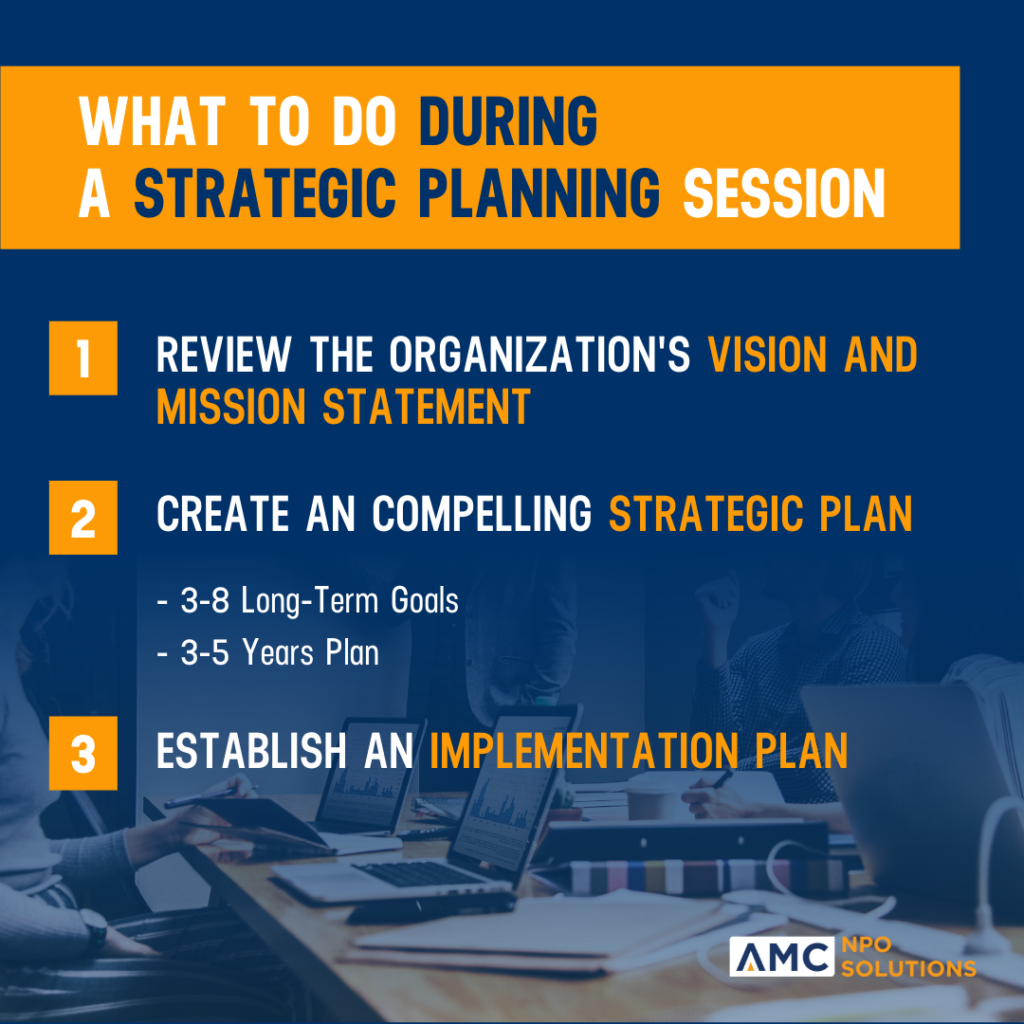
Also read: A Guide To Developing & Monitoring The Strategic Plan For Nonprofits
After the Strategic Planning Session
After the strategic planning session is done, the real work begins by building a task force.
The feasibility study
The team is now tasked with the feasibility study. How does this work? What do we need to do? What resources are required?
Often each board member is then tasked with being a champion of one of the goals that they hold most dear. A goal that they can really commit to.
After doing that, the next step is for each of those champions to then strike a task force.
Build a task force
Now, a task force is a kind of like a committee but it’s not a standing committee. It’s a task force that has a specific task. The task is to review and make recommendations on a specific policy and then report their recommendations to the board for a decision as to what to do next.
That’s the job of a task force, it’s task-oriented and it has a limited time horizon, unlike normal standing committees, for instance a membership committee, finance committee or program committee. All of these committees are what we call standing committees that are always there. There’s always something going on.
However, these task forces are there for a specific need, purpose or project and therefore should have a time horizon, a sunset clause. Be sure that you set up task forces. Have a task force chair and then finally come up with the terms of reference for each of those task forces.
Mistakes to avoid when building a task force
The final piece of advice that I would give you around setting up a task force or a committee is to set up a task force or committee comprised of members.
One of the biggest mistakes that boards make is they feel like the directors have to do all the work themselves. Well, that’s a recipe for burnout that doesn’t work and it’s not sustainable.
If you want something sustainable with leverage, you need to get more people on your team. What that means is your job as the chair is not to do all the work. Your job as chair is to recruit committee members or task force members, engage them, get them involved, get them feeling empowered and invite them to join your team and assist you in doing some of the hard work.
To clarify, the task force would be required to:
- implement tasks
- observe and measure
- conduct more research
- report bi-monthly on the task status and findings
- provide recommendations on how to improve
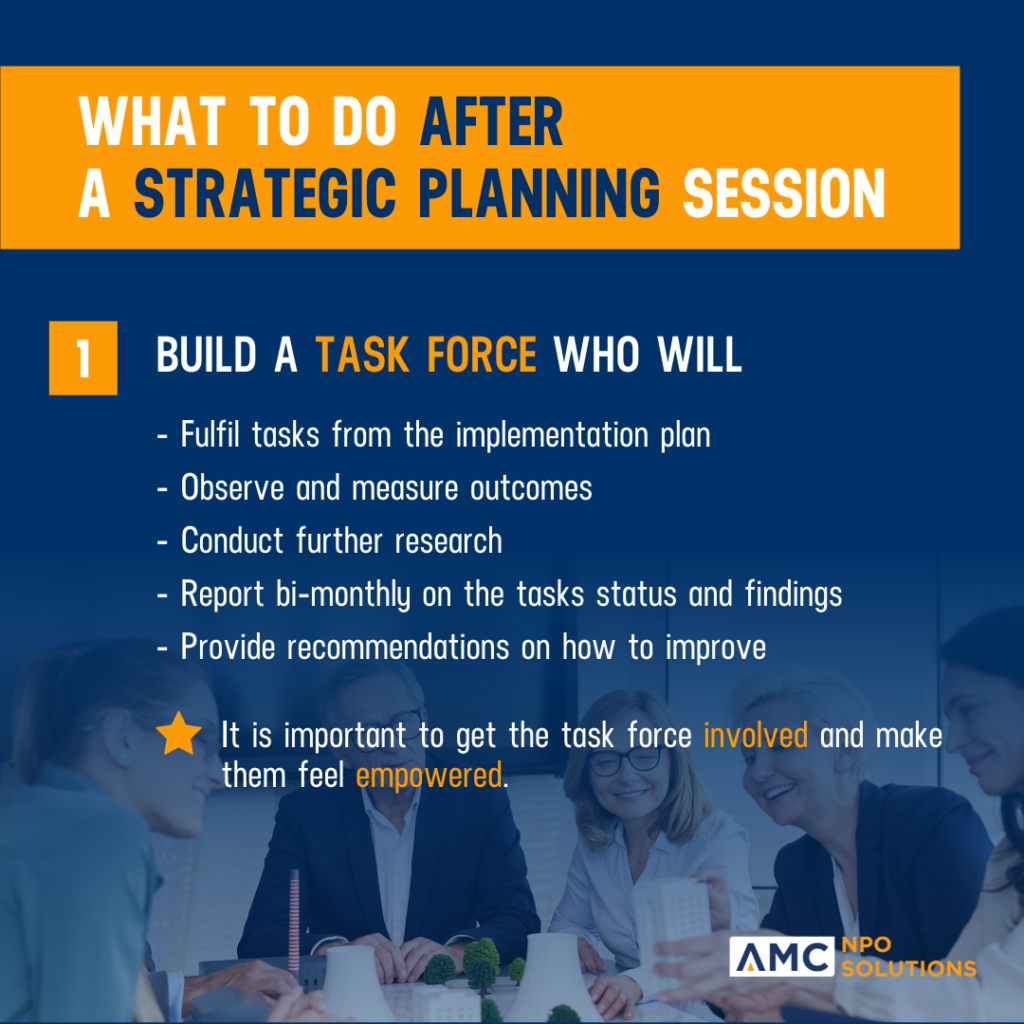
Download the guide on 8 reasons why strategic planning fails and learn what to do instead.
What should be included in a Nonprofit’s Strategic Planning Session:
- Re-affirm the mission of the NPO
- Establish strategic goals for the organization that are consistent with the mission of the NPO
- Identify major objectives that support the strategic goals
- Identify who is responsible for the completion of those strategic goals and objectives
- Establish timelines for the accomplishment of the strategic goals and objectives.
5 Vital Nonprofit Strategic Planning Steps
For any of you who are on a volunteer board of directors, whether you’re a president or vice president, treasurer, secretary, programming, chair, whatever your role is within a not for profit association.
Sometimes you struggle with not really being sure of your role or purpose. What are we working towards? What are our goals? I’m going to share with you really quickly five tips on strategic planning.
1. Schedule A Strategic Planning Session
Most boards will have a strategic planning session as soon as the board is elected. Now what? Collectively you need to reestablish the mission of your associations. It would help if you answered questions together, such as:
- What is our purpose?
- What is our mission?
- What’s our vision?
- Who are our key stakeholders?
- Who are the communities we’re trying to serve?
- What are the different categories of membership?
Ultimately, get together and reaffirm the mission of the association. Sometimes it’s dated, old, and just not relevant. You need to look through your current vision and mission and be willing to tweak it, improve it, and throw it out if needed.
2. Establish & Reinforce Your Mission
The next element to strategic planning is establishing a strategic goal for the organization based on that mission and vision.
We’re talking big picture goals, not small goals; big-time strategic initiatives. What do you guys want to accomplish in your one, two or three-year term as directors? Beyond that, where do you see your organisation going and growing and the next five or 10 years?
Having a time horizon is vital when you’re creating a long term strategic plan.
3. Identify Some Major Objectives
Next, break down those strategic objectives into smaller bite-size goals. That’s where you start going from kind of macro to micro and zeroing in on some smaller bite-sized goals.
You could include your staff, and you can include some people within the organization, paid staff, who can actually add some insights into how we make this happen. But you want to make sure that you’re very clear on that big picture what, and the why first. Then include some of your staff around the implementation.
4. Identify Individual Responsibilities
Tip number four is you need to identify who exactly is responsible for completing those goals and objectives. This is where a lot of nonprofits go wrong. And I get it. I mean, we’re all volunteers. Look, I’m a volunteer director. In fact, I’m the President of a small nonprofit organization, and I know we all volunteer our time. It’s really, really tough.
What’s critical, though, to ensure that those goals actually get achieved is to identify clearly who is responsible for completing those goals and objectives.
Often you have so many great ideas, but then they get dropped. They don’t get executed or implemented because there’s no one there to hold anyone to account.
5. Establish Timelines For Achievement Or Accomplishment
Finally, during your strategic planning session, you need to establish timelines for the achievement or accomplishment of those goals. It’s the last piece of the puzzle to determine: When will these objectives be achieved? And when do those actions need to be completed? When you can identify those timelines, you’re ensuring that your organization’s steps in the right direction.
Create a brighter future for your organization with AMC
AMC’s skilled strategic planning facilitators can help you navigate complex issues and build the transformative plan you need for success.
Whether you have a specific goal, troublesome problem or a new exciting opportunity you need assistance navigating -AMC’s customized strategic planning sessions will help.
Contact us today to learn how AMC’s Strategic Planning facilitators can help your organization develop, improve, and grow.
